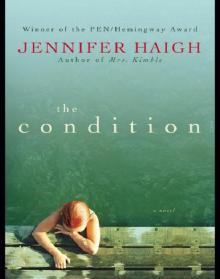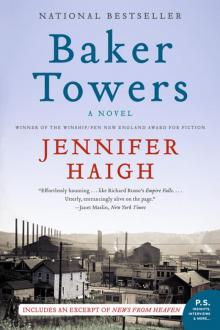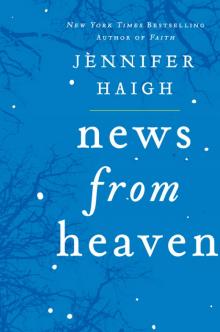- Home
- Jennifer Haigh
Mrs. Kimble
Mrs. Kimble Read online
Mrs. Kimble
A Novel
JENNIFER HAIGH
The author wishes to thank Claire Wachtel, Michael Morrison, Juliette Shapland, and Dorian Karchmar at Lowenstein Associates, for their extraordinary support of this book;
James Michener and the Copernicus Society of America, for their generous financial assistance; and
Dan Pope, for everything else.
Contents
E-book Extras:
Author’s Note
An Interview with Jennifer Haigh
Reading Group Guide
The man died alone…
Birdie
Joan
1972
Dinah
1994
Spring
Praise for Mrs. Kimble
About the Author
Credits
Copyright
About the Publisher
E-book Extra
Author’s Note
Mrs. Kimble didn’t begin as a treatise on marriage and divorce. The book, as I first conceived of it, was about a single mother and her child: Birdie (Ken Kimble’s first wife) and her son Charlie. As I wrote about these two, I became increasingly curious about Charlie’s father. I found myself very drawn to this character, a man who is defined largely by his absence. I wanted to know who he was, how he came into Birdie’s life, and where he went when he left.
Ken Kimble is what I call a “serial husband”—a man who marries again and again, who somehow, in spite of his obvious flaws, has no problem finding women to marry. It’s a phenomenon I’ve observed a few times in life, one that raises an obvious question: what exactly is wrong with these women, so willing to pledge their lives to a man they barely know? The answer, I think, has to do with the way women are socialized. We’re raised to believe that marriage is what completes us, that unless we’ve achieved that particular goal, nothing else we accomplish counts for much. This belief has survived feminism, the sexual revolution, the sweeping social changes of the past 50 years. Women, even bright, successful women, still subscribe to it. One result of thinking this way is that we marry the wrong men.
The three Mrs. Kimbles are women of different generations; they have different expectations of men, and of themselves. Birdie is a product of the 1950s, a woman who resists learning to drive, who’s perfectly happy being a passenger. Joan is in many ways a woman ahead of her time; she chooses career over marriage in an era when few women did, but she’s ambivalent about her choices, and in the end chooses a more traditional life. Dinah, who’s much younger, expects more from a husband; she’s frustrated that Ken isn’t a more involved father to their son. Birdie, on the other hand, would have been content to do all the child-raising herself as long as Ken came home every night, paid the bills, acted like a husband, even if he wasn’t faithful to her.
Mrs. Kimble also looks at the changing shape of family, what that word means in an era of rampant divorce, of blended families with all their prefixes: step-this, half-that. Early in the novel, Birdie’s shame over being divorced is part of the reason she drinks. She lies about where her husband is; Charlie, who’s only seven years old, picks up on her shame and starts lying about it too. At the end of the book we see something of how the world has changed in 25 years, a recognition that blended families can be quite happy and functional, prefixes and all.
The three Mrs. Kimbles aren’t victims. Ken Kimble isn’t some kind of sociopath. He is, in fact, a very ordinary man; he simply takes what is given to him. He is in some sense a blank slate, a cipher; and that works to his advantage. Birdie, Joan and Dinah are looking for different things; yet each is able to convince herself that Ken Kimble is what’s missing from her life. The novel examines how and why that happens. In that way Mrs. Kimble truly is a meditation on marriage: why women hunger for it, what we’re willing to sacrifice in order to have it.
I hope that you enjoy Mrs. Kimble.
E-book Extra
An Interview with Jennifer Haigh
Mrs. Kimble
A Novel
by Jennifer Haigh
How did producing a full-length novel compare to writing short stories? Was it a challenge to create three distinct but intertwining narratives for Mrs. Kimble?
Short stories are to novels what dating is to a long marriage. A new story is very exciting; there’s a wonderful sense of discovery that comes with inventing and exploring new characters. Because a novel takes so long to write, you’re still plugging away at it long after the initial glow has faded. Novelists, like spouses, don’t get to start from scratch when the novelty wears off. They’re living with the choices they made days, months, years before.
Is there a part of you in any of Ken’s wives, or in Ken himself?
I identify with all the characters in the book. More strongly with the wives, but with Kimble too. Some readers seem to disagree, but I never thought of him as a sociopath. He is in many ways a very ordinary person. He simply takes what is given to him.
The voice with which you narrate Mrs. Kimble is very distinctive; the sentence structure is honed without being sparse, while your dialogue sounds casual but almost always carries an emotionally charged subtext. Did this voice evolve while you were a student in Iowa, or has it always been your vehicle for storytelling?
The narrative voice of Mrs. Kimble is very much my voice; I think it comes through in all my work. I aim for precision in the sentences because that’s the sort of writing I admire. I have a great respect for writers who are humble, whose language allows the reader to see the story but doesn’t get in the way. Language is a window, and if the window is clean, you shouldn’t be aware you’re looking through glass.
Do you consider Mrs. Kimble to be a cautionary tale?
I didn’t intend Mrs. Kimble as a cautionary tale, just a story about life. Then again, life is instructive; we draw lessons from our own experiences and other peoples’.
Any plans for your next novel?
I am now deep into my next novel. It’s like Mrs. Kimble in that it involves a family and much of the story is set in the past. It’s another intimate novel, showing the insides of people’s lives. That’s what interests me as a writer. Private stories, what people think and do and say when they think no one is watching.
E-book Extra
Reading Group Guide
Mrs. Kimble
A Novel
by Jennifer Haigh
Introduction
Deftly exploring the poignant landscape of longing, Mrs. Kimble traces the lives of three women who marry the same opportunistic man, a chameleon named Ken Kimble. He seduces each of them with sensitivity and generosity, and with his obsessively perfected physique. But marriage reveals Ken’s true persona—elusive, workaholic, and hungry for extramarital affairs. All three of his wives are sustained by the hope that he will once again become the hero they fell in love with. For Ken’s children, the reality of their father’s absence is at once devastating and indelible. And for Ken himself, the price of maintaining illusions appears to be negligible.
Spanning four decades in the life of a tantalizingly unknowable man, Mrs. Kimble vividly portrays the pain of unequal affections. In a voice that is neither maudlin nor sentimental, Jennifer Haigh has crafted a debut novel that captures journeys of the heart in a wholly original way. We hope that the following questions will enhance your discussion of this provocative triumph in fiction.
Discussion Topics
Consider the similarities and differences among Birdie, Joan, and Dinah. Is there a common thread that attracts Ken to each of them.
Joan and Dinah have physical traits that cause them to feel self-conscious and prone to rejection. Do you consider Birdie’s vulnerabilities to be equally physical in nature, or are they purely emotional?
What motivates Ken? In your opinion, what enables him to so suddenly shift from being charming to vapid? To what do you attribute his compulsive dishonesty?
The novel’s title reflects the tradition of taking a husband’s surname after marriage. All of Ken’s wives change their last names and become Mrs. Kimble. What does this indicate about the tradition, gender, power, and identity in Ken’s marriages?
Birdie appears in all three parts of the novel. What were your initial impressions of her? Did your opinion of her shift as her life story unfolded?
American society experienced significant changes between the 1960s and the 1990s. Did this appear to affect Ken’s various marriages, or was his behavior consistent across the mores of all decades?
How might Birdie’s life have been different had her father not interfered with her attraction to Curtis Mabry? What is the effect of the Mabry family’s presence in the novel?
Though the novel’s characters are for the most part indifferent to spirituality, religion provides a frequent backdrop in Mrs. Kimble. What is the significance of Ken’s Bible school past? How did you react when he convinced Joan of his Jewish heritage?
Do you believe that Ken’s abandonment of Birdie was the sole cause of her emotional breakdown? How might her life have played out if he hadn’t left her?
How does Ken’s departure affect his children’s attitude toward love? Do their relationships reflect or defy their parents’ example?
Jennifer Haigh builds the storyline of Mrs. Kimble around brief scenes rather than lengthy, uninterrupted chapters. What is the effect of this technique?
Ken is not the only predatory man in the novel; Birdie is exploited by the mechanic she meets as a waitress, for example. Do the novel’s characterizations of men and women match your own experience with the opposite sex?
With which of Ken’s wives were you most able to relate? How would you have responded in each of their situations?
Though Ken is the most obviously secretive character in the novel, all of his wives possess a certain degree of secrecy and denial. Do you believe that it’s possible to lead a completely honest life—including self honesty?
Ken is an enigma, yet his character is drawn in rich detail. Discuss the significance of his vanity, his attraction to younger women, and his apparent inability to love or show genuine affection. What is the relevance of his conservative childhood, particularly the death of his brother?
Food is mentioned throughout the novel, including Charlie’s perpetual hunger as a child; Birdie’s botched attempts to buy groceries; Ken’s aversion to seafood, which causes Joan to tailor her menus; and Dinah’s Thanksgiving reunion and culinary expertise. Discuss some of your most meaningful memories regarding food.
What makes Ken’s cause of death particularly ironic and fitting?
While there are clearly three Mrs. Kimbles, are there also three Mr. Kimbles? Does each wife represent a separate identity for Ken?
What variations on love (parental, romantic, erotic) are presented in Mrs. Kimble? Which characters appear to experience the most authentic forms of love?
20. The novel closes with Ken’s children brought together by Dinah. Charlie embraces his role as Brendan’s big brother and father figure. What do you predict for the family after Ken’s death?
The man died alone
, in a baby blue Eldorado on Route A1A, waiting for the drawbridge to be lowered. As his heart seized, his foot lifted off the brake; the car crept forward and nudged the bumper of a lawn service truck. The driver of the truck radioed his office and waited for the ambulance to arrive. By the time it came, the man was already dead.
He had lived alone in a furnished apartment on Largo Boulevard with a sunny terrace and a view of the ocean; in the five months he’d lived there, no one in the building had noticed any visitors. In his apartment police found no books, no photos or personal correspondence, just recent newspapers and copies of the Broward County Real Estate Guide, a free publication distributed in boxes on the beach. In the bathroom were several bottles of pills, all unlabeled; according to the coroner, they were medications to lower blood pressure and cholesterol, slow a racing heart. The man had owned a dozen fine suits and three pairs of expensive running shoes. A neighbor said he’d risen at dawn each day to run on the beach. On the table next to his bed was a gold wedding band.
He’d been seen eating breakfast each morning at a coffee shop down the street—the same thing every day, black coffee and toast. He sat alone at the counter reading newspapers: a local daily, the Miami Herald, and the Washington Post.
How he spent the rest of the day, nobody knew. He was seen twice at a neighborhood drugstore, buying vitamins. He paid his rent with a personal check; five months ago he’d opened an account at First Florida bank. An associate at a local Cadillac dealership remembered selling him the car. He would remember it forever. The man had handed him sixty thousand dollars in cash.
He’d died on a Friday night, the beginning of the Memorial Day weekend. The Department of Motor Vehicles would be closed until Tuesday; pulling the man’s driving record might have taken days, but the sheriff knew someone at the DMV. The man’s Florida license was brand new; no address had been recorded from the Virginia one he’d surrendered. The Virginia DMV had an address on file but no phone number.
The body waited in the county morgue. Plaque in its arteries, an enlarged heart starved of blood. If no relatives were located, it would be buried in the municipal cemetery at the man’s own expense. His checking account at First Florida contained half a million dollars.
The police kept trying.
Birdie
Virginia
1969
Charlie’s mother sat cross-legged on the living room floor, her nightgown pulled over her knees, a spill of photographs scattered across the faded carpet. Years later he would remember the sound of the scissors’ blades gnawing into the glossy paper, his little sister Jody wailing in the background, the determined look on their mother’s face.
She had been drinking; her teeth were stained blue from the wine. She worked methodically, the tip of her tongue peeping out the corner of her mouth. The defaced photos she stacked in a neat pile: Christmases, family picnics, Fourths of July, each with a jagged oval where his father’s face had been. One by one she slid the photos back into their frames. She climbed unsteadily to her feet and placed the frames back on the mantelpiece, the sideboard table, the naked hooks dotting the cracked plaster wall.
“Better,” she said under her breath. She took Jody by the hand and led her into the kitchen. Charlie dropped to his knees and picked through the pile of trash on the floor. He made a pile of his father’s heads, some smiling, some wearing a cap or sunglasses. He filled his pockets with the tiny heads and scrabbled out the back door.
His father was there and then he wasn’t. A long time ago he’d taken them to church. Charlie could remember being lifted onto the hard pew, the large freckled hand covering his entire back. He remembered playing with the gold watchband peeking out from under his father’s sleeve, and the red imprint it left on the skin underneath.
His father had a special way of eating. He rolled back the cuffs of his shirt, then buttered two slices of bread and placed them on either side of the plate. Finally he mixed all his food into a big pile—peas, roast, mashed potatoes—and ate loudly, the whole meal in a few minutes. Charlie had tried mixing his own food together, but found himself unable to eat it; the foods disgusted him once they touched, and his mother got mad at the mess on his plate.
His father made pancakes, and sucked peppermints, and whistled when he drove them in the car. On the floor of his closet, he kept a coffee can full of change. Each night lying in bed, Charlie would wait for the sound of his father emptying his pockets into the can, nickels and dimes landing with recognizable sounds, some tinny, some dry and dusty. It was always the last thing that happened. Once he heard the coins fall, Charlie would go to sleep.
Birdie was unwel
l. It was mid-morning when she opened her eyes, the room filled with sunlight. She rolled over and felt a sharp pain over her right eye. The other side of the bed was still made, the pillow tucked neatly under the chenille spread. She had remained a considerate sleeper, as if her sleeping self hadn’t yet figured out that the whole bed was hers alone.
She lay there a moment, blinking. She had been dreaming of her childhood. In the dream she was small, younger than Charlie; she and Curtis Mabry, the housekeeper’s son, had hidden in the laundry hampers. “You nearly give me a heart attack,” said the housekeeper when she discovered them. “You’re lucky I don’t tell your mother.”
Through the thin walls she heard movement, the bright tinkling music of morning cartoons. She lifted herself out of bed, her nylon nightgown clinging to her back. In the living room the children looked up from the television.
“Mummy,” Jody squealed, springing off the couch and running to hug her leg. She wore shortie pajamas, printed with blue daisies. Birdie wondered for a moment who’d dressed the child for bed. She couldn’t remember doing it herself.
“Can I go outside?” said Charlie. He lay sprawled on the rug, too close to the television.
“May I go outside please,” she corrected him. “Yes, you may.”
He scrambled to his feet, already in socks and sneakers. The screen door spanked shut behind him. Birdie unwrapped Jody’s small arms from her leg. “Let me get you some breakfast,” she said. The children seemed to lie in wait for her, to ambush her the moment she crawled out of bed, full of energy and raging needs. At such times it could be altogether too much—her stomach squeezed, the sign of a rough morning ahead—for one person.
She took Jody into the kitchen. It was a point of pride for Birdie: her kitchen was always immaculate. The room simply wasn’t used. She hadn’t cooked in weeks, hadn’t shopped except for brief trips to Beckwith’s corner store, to buy wine and overpriced loaves of bread.

 The Condition
The Condition Zenith Man
Zenith Man Baker Towers
Baker Towers News From Heaven
News From Heaven Mrs. Kimble
Mrs. Kimble